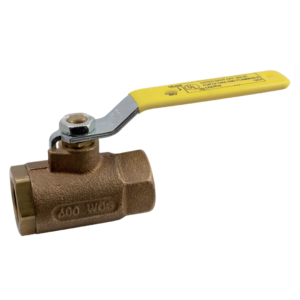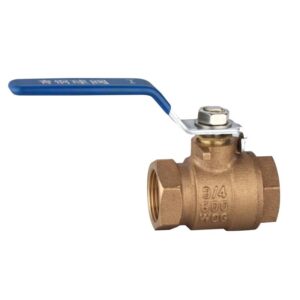Description
Brass Ball Cock Valve
JX-0402
- Brass Ball Valve
- Size 1/2″ -2.”
- Max work temperature; -10℃-120℃
- Max work pressure;30bar
- Media; Water; Seawater;
- Thread connection : (G, Rc, RP) BSP, BSPT, NPT
- FXM thread with DZR brass
- Brass for corrosion resistance, ductility at high temperatures, and low magnetic permeability.
- Blue chrome-plated lever handle for on/off manual control.
- The inside thread with sealant for better sealing.
- Since 2000 Jiaxin has been producing High-Quality fluid control Accessories
What are ball valves used for?
A ball valve is a form of quarter-turn valve which uses a hollow, perforated, and pivoting ball to control flow through it. It is open when the ball’s hole is in line with the flow and closed when it is pivoted 90 degrees by the valve handle.
Ball valves are standard plumbing fixtures found in residential and industrial settings. They offer several advantages that make them the preferred choice for many applications, including:
(1) A ball valve can be rotated 360 degrees to precisely control fluid flow. This is especially helpful when working with high-pressure systems, as they allow you to regulate how much gas or liquid flows at any given time.
(a) Ball valves can be rotated 360 degrees to precisely control fluid flow.
(b) They have an excellent shut-off ratio and don’t often leak if damaged.
Brass Ball Cock Valve
Brass Ball Cock Valves are a popular choice for many households. They are used in residential homes and commercial buildings to control water flow from the main supply line into a tank or cistern. Their durability and corrosion resistance make them ideal for indoor and outdoor use.
These valves come in manual or automatic configurations, offering versatile control of hot, cold, or mixed-temperature water. Manual valves require users to manually open and close the valve’s handle, while automated versions allow for adjustable settings that can be controlled using a timer, switch, or button. These valves also have an internal float system that ensures they remain closed when the water level reaches its desired height. This prevents overflow in case of malfunctioning plumbing fixtures.
The ease of installation makes brass ball cock valves an attractive option for anyone looking to upgrade their existing plumbing system without breaking the bank.
History of Valves
Valves have been used for centuries to control the flow of liquids and gases. They are essential components in plumbing, industrial machinery, and other systems. One type of valve is the brass ball cock valve, which has a long history of use for controlling and regulating water supply.
The brass ball cock valve was first developed over two hundred years ago as an improvement from earlier designs. These valves were designed with a simple mechanism that allowed them to regulate water flow quickly and easily. As technology advanced during the 20th century, new materials like plastic started being used in manufacturing valves instead of brass. However, due to its durability, reliability and corrosion resistance properties, brass continues to be one of the most popular choices for making valves today.
Types of Valves
Valves are essential components in many types of fluid systems. They control the flow of liquids, gases, and steam and can be used to regulate pressure, temperature, and other variables. Valves come in various designs, shapes, and sizes to suit different applications – from the smallest shut-off valves to the largest control valves. One type of valve widely used today is the brass ball cock valve.
A brass ball cock valve is a form of water shut-off valve which uses a hollow metal sphere or “ball” as its mechanism for closing off a water supply line. This type of valve is commonly used in residential plumbing fixtures such as toilets and sinks, as well as industrial applications where there is potential for backflow or contamination if not properly sealed off by an appropriate valve design.
Installation Process
The installation process of a brass ball cock valve is an important part of its operation. Installing this type of valve requires careful attention to detail and knowledge of the plumbing system. Failure to install it correctly can lead to leaks and water damage.
To begin the installation process, ensure you have all the necessary components, such as nuts, bolts, washers, and pipe fittings. Be sure that all parts are clean before assembly begins. The parts should be properly lubricated for smooth operation when installed in place. Next, shut off the water supply before loosening or disconnecting any existing pipes to make room for the ballcock valve. Finally, carefully attach the new brass ballcock valve using the appropriate tools and following the instructions. Ensure all connections are securely tightened so there will not be any leaks once the water supply has been turned back on again.
Maintenance and Cleaning
Maintenance and cleaning of brass ball cock valves is essential to ensure they remain in good working order. Brass ball cock valves are vital components in the plumbing system, controlling water flow to the toilet tank. To keep them functioning properly, it is important to periodically inspect them for signs of wear and tear, such as corrosion or other damage. Regular cleaning will also help reduce maintenance costs by removing any dirt or debris that may have built up over time.
To clean a brass ball cock valve, it is best to use a soft cloth dampened with warm soapy water and gently wiped along the surface of the valve’s body. This should be done regularly to remove any dirt or corrosion that may have accumulated on the surface. Additionally, any visible components should be wiped down with a dry cloth after use to ensure proper operation in future uses.








